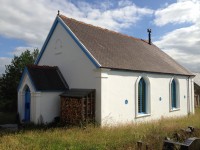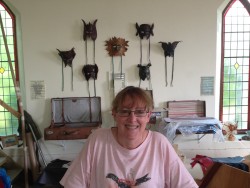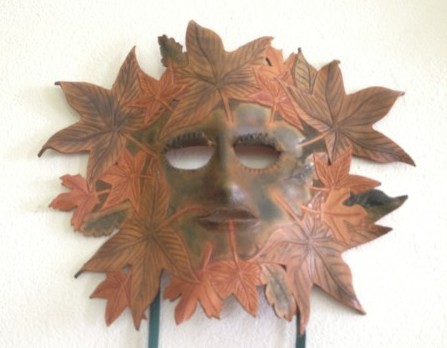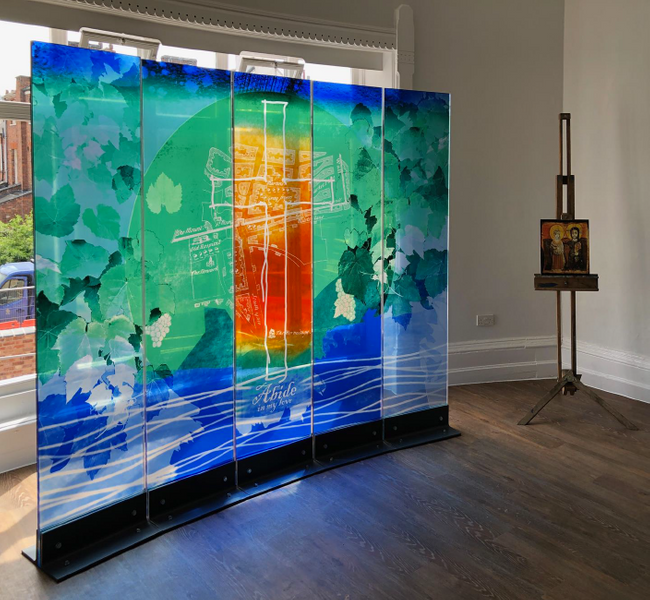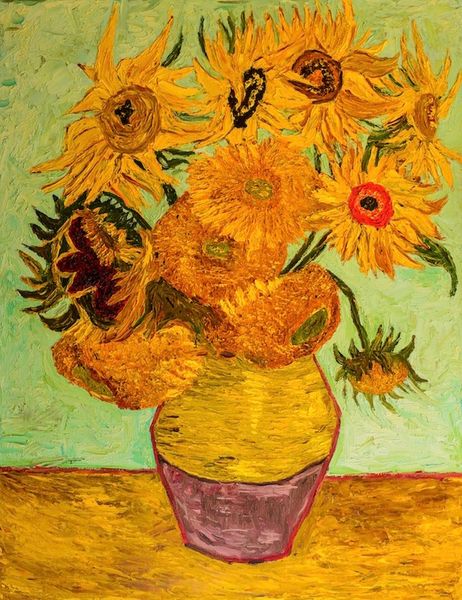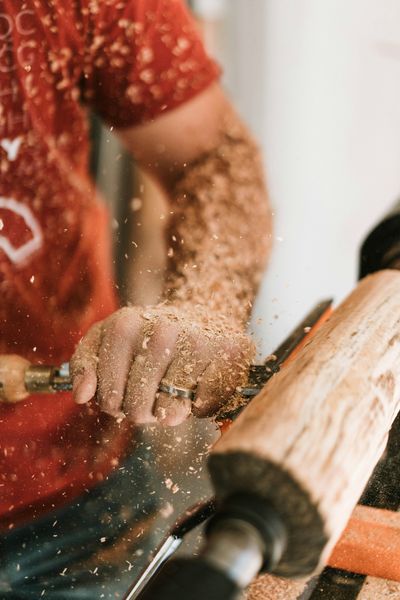Gaynor Howell is the owner of Pembrokeshire Leatherwork and runs leather mask and bag making courses.
How does your day start?
The day starts before I’ve gone to bed! Usually with preparing for the next day, laying things out ready for a course and checking and responding to emails.
I usually have breakfast at home in Chapel house, next door, then I come here to my leather workshop which is in a mid 19th Century Welsh Methodist chapel. It served the community for well over 100 years as a place of worship but you don’t feel as though you’re in chapel, there is a very clear feeling in here.
What does your working day consist of?
I have a leatherwork apprentice, so the working day starts with her and I allocating our jobs. We often have work over from the day before which needs to be completed, such as finishing a commission or a trade order, or it might be drawing up a design or making a sample.
On beautiful days (like today) we sit outside for our tea and lunch breaks, spending longer on nicer days of course!
Towards the end of the day we usually have a review of what we’ve done. If we are running a course the following day we clear the decks and set up, getting work benches ready for the students and setting out the tools. Course days are long, which is why we tend to work a four day week and have Wednesdays off.
There are just the two of us here which means we are kept very busy but we do take trips out to museums etc to keep the inspiration flowing. This yearwe will also be attending the Cuir A Paris show in September - It’s a trade show where we can keep an eye on the trends for next Autumn and Winter and check out the new leathers on the market.
What do you love about leather?
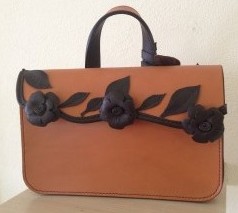
Gary Greenwood was an Australian leather ‘artist’. His stuff is sculptural and he could make things out of leather that you wouldn’t believe possible, like complicated string instruments - that worked! I would love to get out to Australia some day to see his work.
What I love most about vegetable tanned leather (the only kind I work with) is that it can be moulded. Basically I can make it take on a 3D shape, because it can be wet formed into something and keeps that shape permanently.
There is an unexpectedness about leather; it can change so much in its lifetime, it has a natural tendency to just do it’s own thing and keep a character of it’s own. I love the fact that the more weathered and worn it gets, the better it looks!
How did you get into leatherwork?
I started working with textiles initially and from there progressed to leather. I soon began appreciating the qualities of vegetable tanned leather and predominately still work with that now.
What can people learn on your courses?

Most students stay in the local town of Narberth, but some choose to camp. For lunch we sometimes head out to the Llys Y Fran tea rooms. Or people bring a packed lunch and we sit out on the patio.
The leather mask making courses are completely different from the bag making. These students often come because they have been invited to a masqued ball, which seem to be on the increase these days. Half an hour in a plastic mask would be enough to make anyone want to go and make a leather one! I also get a fair few theatrical people or costume and fashion students looking for specialist or quirky skills.

The mask making course takes nine hours usually... it’s a full day!! When the students come in we do a quick introduction and the obligatory health and safety, then immediately we immerse the leather in water. After ten minutes the leather fibres have softened, the ice has been broken between students and then it’s to the workbenches to start securing the masks and developing unique d
 I like to allow my leather to do it’s thing, which means it completely changes colour over time, as vegetable tanned leather is supposed to. It develops what is called a patina and I love this process. People leave here with the most beautiful coloured masks and bags and I try and take a photo of every single one of them.esigns. The masks are all one-offs and tend to take on a character of their own.
I like to allow my leather to do it’s thing, which means it completely changes colour over time, as vegetable tanned leather is supposed to. It develops what is called a patina and I love this process. People leave here with the most beautiful coloured masks and bags and I try and take a photo of every single one of them.esigns. The masks are all one-offs and tend to take on a character of their own.
What are you working on now?
Currently I’m making a flight bag for someone, a one-off commission of a new design.
We’re also working on a new range that we will take to the Liberty’s Open Call in 2014. You have 3 minutes to present your pitch and this year they invited us back to show them a fuller range. It’s a good way to stay fresh and on your toes!
We prefer to make classical items that last for many years and are unlikely to go out of fashion. We also often do small runs for people who want just 6 or 12 of something.
Where do you get your inspiration from?
My inspiration? I don’t know. Sometimes I think it comes from being a very independent person and losing patience with looking through shops for the thing I want. It might sound strange but I’m not a handbags sort of girl. I like to do things myself and if I have a bag in mind I make it - I like being here in my chapel-workshop working on something new.
The masks are different from the bags of course. All of the masks in here were based on “bwcas”. Bwcas are little folklore people who are said to live in houses yet are never seen. Welsh bwcas are perhaps along the same lines as the ‘tidy elves’ or the ‘borrowers’. And this is how my faces come about. I have read various accounts of the bwcas in Wales and other places and each one of these masks is my interpretation of one of those. They have to start somewhere!
What are the essentials of any leatherworkers tool bag? (What would you tell a trainee leatherworker to get their hands on in order to pursue the craft?)

A stitching clam
A sharp harness awl
A scratch awl
A pricking iron
A small hammer
Some linen thread
Harness needles
A small block of beeswax
Will you listen to music today as you work or do you need silence? (if yes, what music?)
We have classic FM in the background most days. I like the radio on in the workshop though my assistant would probably want to change the station (she is nineteen). I like background music that doesn’t distract. If there are a number of people on a course I have it on very low, but because we’re using knives, if I see someone tapping their foot the radio goes off. If we’re just stitching sometimes we put a CD on, but it has to be background to avoid losing concentration...
Have you ever had a student where you recognised raw talent?
Some people have a natural affinity for the leather. I had a lady come on a course recently who had a degree from Hereford Arts college and she was so much a natural leatherworker, I wanted to give her a job! I also had a young woman who came on a mask making course. She was quiet but determined and then I discovered she was a qualified doctor! It might seem odd that a doctor would be hacking up a bit of animal skin, but there she was, very gifted.
What’s the daftest thing one of your students did in a workshop?
I once had someone sitting with a mask in their lap, cutting into it with a knife... I nearly had a heart attack and she couldn’t seem to stop! She didn’t seem to see that the worktop was much safer... In her defence she was very artistic and totally engrossed in trying to achieve an imagined outcome
What do you do at the end of the day to relax?
I don’t really; my evenings are often taken up with business and emails. I like reading design books and magazines, keeping up with the latest trends. I suppose it’s work-related relaxing. We don’t have a telly and its highly unlikely I will ever buy a DVD and watch a film. I can’t sit still that long (this is the longest I’ve ever sat in one place!)
 What is the single most important thing for craft students to learn?
What is the single most important thing for craft students to learn?
Patience. You can’t go on a course and expect a perfect result. You go on a course to learn the process and the techniques. Then you take those techniques home and develop them. You can’t expect to get it absolutely right straight away but you can expect to go on a craft course and have a great time, meet people and learn how to do what you want to do.
How would you like to be remembered?
I would like to be remembered for making things that have made people happy, that people have been proud to own.

